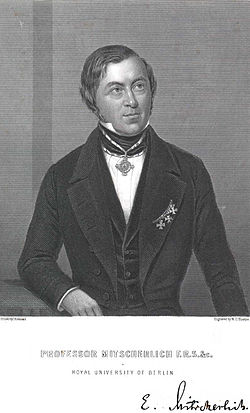Eilhard Mitscherlich
| Eilhard Mitscherlich | |
|---|---|

Eilhard Mitscherlich (1794-1863)
|
|
| Born |
7 January 1794 Neuende, Lordship of Jever |
| Died | 28 August 1863 (aged 69) Schöneberg, Prussia |
| Residence | Germany |
| Nationality | German |
| Fields | Chemist |
| Institutions | University of Berlin |
| Alma mater |
University of Göttingen University of Berlin |
| Doctoral advisor | Friedrich Stromeyer |
| Doctoral students | Heinrich Gustav Magnus |
| Known for |
Selenic acid Law of isomorphism |
| Notable awards | Royal Medal (1829) |
Eilhard Mitscherlich (7 January 1794 – 28 August 1863) was a German chemist, who is perhaps best remembered today for his discovery of the phenomenon of isomorphism (crystallography) in 1819.
Mitscherlich was born at Neuende (now a part of Wilhelmshaven) in the Lordship of Jever, where his father was pastor. His uncle, Christoph Wilhelm Mitscherlich (1760–1854), professor at the University of Göttingen, was in his day a celebrated scholar. Eilhard Mitscherlich was educated at Jever by the historian Friedrich Christoph Schlosser, and in 1811 went to the University of Heidelberg devoting himself to philology, with an emphasis on the Persian language. In 1813 he went to Paris to seek permission to join the embassy which Napoleon I of France was establishing in Persia.
The abdication of Napoleon Bonaparte in 1814 put an end to this, and Mitscherlich resolved to study medicine in order that he might enjoy that freedom of travel usually allowed in the East to physicians. He began at Göttingen with the study of chemistry, and this so arrested his attention that he gave up his idea to travel to Persia. From his days in Göttingen dates the treatise on certain parts of Eurasian history, compiled from manuscripts found in the university library and published in Persian and Latin in 1814, under the title Mirchondi historia Thaheridarum historicis nostris hucusque incognitorum Persiae principum.
In 1818 Mitscherlich went to Berlin and worked in the laboratory of Heinrich Friedrich Link (1767–1851). There he studied phosphates, phosphites, arsenates and arsenites, and was able to confirm the conclusions of Jöns Jakob Berzelius as to their composition. His observation that corresponding phosphates and arsenates crystallize in the same form was the germ from which grew his theory of isomorphism (crystallography), which theory was published in the proceedings of the Berlin Academy of Sciences in December 1819. In that same year Berzelius suggested Mitscherlich to the Prussian education minister Karl vom Stein zum Altenstein as successor to Martin Heinrich Klaproth at the University of Berlin. Altenstein did not immediately carry out this suggestion, but he obtained for Mitscherlich a government grant to enable him to continue his studies in Berzelius' laboratory at the Karolinska Institutet in . Mitscherlich returned to Berlin in 1821, and in the summer of 1822 he delivered his first lecture as extraordinary professor of chemistry at the university; in 1825 he was appointed ordinary professor. In 1823 Mitscherlich was elected as foreign member of the Royal Swedish Academy of Sciences.
...
Wikipedia
